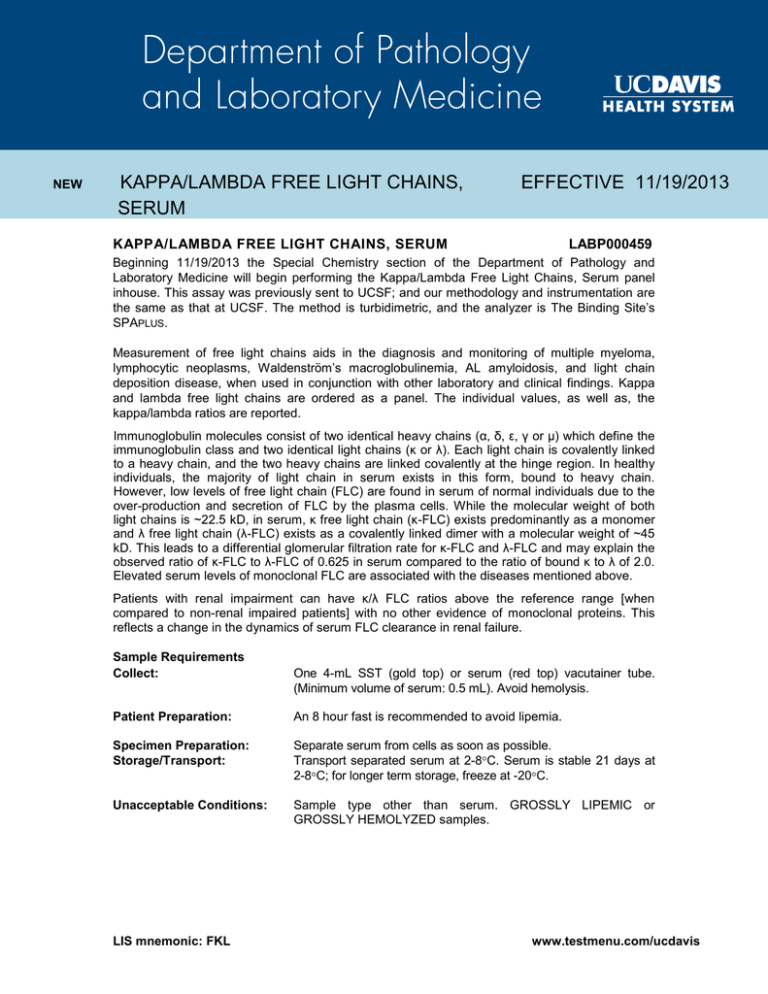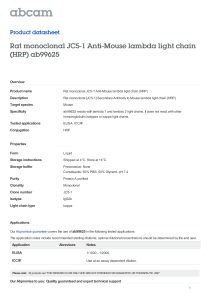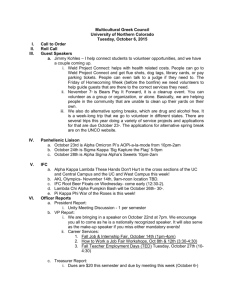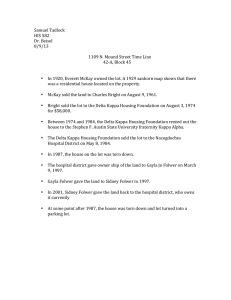KAPPA/LAMBDA FREE LIGHT CHAINS, ... SERUM KAPPA/LAMBDA FREE LIGHT CHAINS, SERUM
advertisement

NEW KAPPA/LAMBDA FREE LIGHT CHAINS, SERUM EFFECTIVE 11/19/2013 KAPPA/LAMBDA FREE LIGHT CHAINS, SERUM LABP000459 Beginning 11/19/2013 the Special Chemistry section of the Department of Pathology and Laboratory Medicine will begin performing the Kappa/Lambda Free Light Chains, Serum panel inhouse. This assay was previously sent to UCSF; and our methodology and instrumentation are the same as that at UCSF. The method is turbidimetric, and the analyzer is The Binding Site’s SPAPLUS. Measurement of free light chains aids in the diagnosis and monitoring of multiple myeloma, lymphocytic neoplasms, Waldenström’s macroglobulinemia, AL amyloidosis, and light chain deposition disease, when used in conjunction with other laboratory and clinical findings. Kappa and lambda free light chains are ordered as a panel. The individual values, as well as, the kappa/lambda ratios are reported. Immunoglobulin molecules consist of two identical heavy chains (α, δ, ε, γ or μ) which define the immunoglobulin class and two identical light chains (κ or λ). Each light chain is covalently linked to a heavy chain, and the two heavy chains are linked covalently at the hinge region. In healthy individuals, the majority of light chain in serum exists in this form, bound to heavy chain. However, low levels of free light chain (FLC) are found in serum of normal individuals due to the over-production and secretion of FLC by the plasma cells. While the molecular weight of both light chains is ~22.5 kD, in serum, κ free light chain (κ-FLC) exists predominantly as a monomer and λ free light chain (λ-FLC) exists as a covalently linked dimer with a molecular weight of ~45 kD. This leads to a differential glomerular filtration rate for κ-FLC and λ-FLC and may explain the observed ratio of κ-FLC to λ-FLC of 0.625 in serum compared to the ratio of bound κ to λ of 2.0. Elevated serum levels of monoclonal FLC are associated with the diseases mentioned above. Patients with renal impairment can have κ/λ FLC ratios above the reference range [when compared to non-renal impaired patients] with no other evidence of monoclonal proteins. This reflects a change in the dynamics of serum FLC clearance in renal failure. Sample Requirements Collect: One 4-mL SST (gold top) or serum (red top) vacutainer tube. (Minimum volume of serum: 0.5 mL). Avoid hemolysis. Patient Preparation: An 8 hour fast is recommended to avoid lipemia. Specimen Preparation: Storage/Transport: Separate serum from cells as soon as possible. Transport separated serum at 2-8°C. Serum is stable 21 days at 2-8°C; for longer term storage, freeze at -20°C. Unacceptable Conditions: Sample type other than serum. GROSSLY LIPEMIC or GROSSLY HEMOLYZED samples. LIS mnemonic: FKL www.testmenu.com/ucdavis Reference Interval: For Normal renal function (EGFR ≥ 60 mLs/min/1.73m Free Kappa Light Chains 3.3 - 19.4 mg/L Free Lambda Light Chains 5.7 - 26.3 mg/L K/L Ratio 0.26 - 1.65 3 3 For patients with EGFR < 60 mL/min/1.73m K/L Ratio 0.37 – 3.1 Routine Testing: Tuesday and Thursday day shift, STAT testing is not available. Interpretation of Results Kappa and lambda free light chain results should be considered under the following categories and investigated appropriately: Test Results Normal samples: serum kappa, lambda, and kappa/lambda ratio are all within the normal ranges. Abnormal kappa/lambda ratio Low concentrations of kappa, lambda, or both Elevated concentrations of both kappa and lambda with normal kappa/lambda ratio Elevated concentrations of both kappa and lambda with an abnormal kappa/lambda ratio Interpretation If accompanying serum electrophoretic tests are normal, monoclonal gammopathy is unlikely. Supports the diagnosis of a monoclonal gammopathy and requires further investigation. Borderline elevated kappa/lambda ratios occur with renal impairment, and may require appropriate renal function tests. Indicate bone marrow suppression. May be due to (1) renal impairment (common); (2) Over-production of polyclonal FLC from inflammatory conditions (common); (3) Biclonal gammopathies of different FLC types (rare). Suggest a combination of monoclonal gammopathy and renal impairment. If you have questions or need additional information please contact Laboratory Client Services at 734-7373 or email pathologyclientservices@ucdmc.ucdavis.edu. LIS mnemonic: FKL www.testmenu.com/ucdavis


